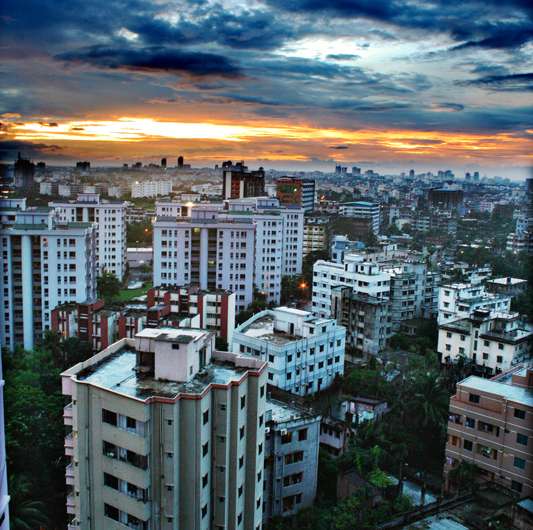March 29, 2016 report
Study finds disease transmission dynamics linked to climate can differ within a megacity

(Medical Xpress)—A small team of researchers from the U.S. and Bangladesh has found that transmission of diseases not typically associated with climate can have different dynamics in a very large city. In their paper published in Proceedings of the National Academy of Sciences, the researchers describe their study, what they found and why they believe that infectious diseases should be studied differently in large cities, particularly those in developing countries and in the tropics.
Rotavirus infections are responsible for a host of stomach flu outbreaks across the globe and kill hundreds of thousands of children and infants each year—infections rob victims of nutrients and liquids due to diarrhea, leaving them unable to recover. Unlike cholera and other diarrheal diseases, rotavirus is not considered to be impacted by climate because it is transmitted from person-to-person, rather than from an external source to people, such as from unsanitary water. In this new effort, the researchers conducted a study to show that climate is able to have an indirect impact on rotavirus infection rates in megacities such as Dhaka, Bangladesh.
Suspecting that large dense population areas, such as those found at the core of a megacity, might feel the impact of transmissible diseases more strongly than people in more rural areas, such as those at the periphery of megacities, the researchers obtained and analyzed twenty two years of climate and disease statistical data for Dhaka and surrounding areas. In so doing, they found that the rate of rotavirus infections was approximately three times higher in the city core than in the periphery, and also that the core had two "seasons" compared to just one for the periphery. Situated very near the Tropic of Cancer, Dhaka is very sensitive to the monsoon season, when heavy rains fall for many days, causing flooding. In rural areas, and those on the periphery of Dhaka, infection rates for rotavirus and other diseases such as cholera rise. But in the core, the researchers found, rates rise both during the monsoon season and in the middle of the winter.
The researchers cannot say for sure why there is a second season for rotavirus in the core but suggest it is likely heavily tied to the extremely dense population that exists there. It also indicates, they point out, that it can be tied to climate and suggests other non-climate tied diseases likely also have infection seasons in megacities, which suggests efforts to reduce the impacts of such infections should be modified to account for differences in megacities.
More information: Pamela P. Martinez et al. Differential and enhanced response to climate forcing in diarrheal disease due to rotavirus across a megacity of the developing world, Proceedings of the National Academy of Sciences (2016). DOI: 10.1073/pnas.1518977113
Abstract
The role of climate forcing in the population dynamics of infectious diseases has typically been revealed via retrospective analyses of incidence records aggregated across space and, in particular, over whole cities. Here, we focus on the transmission dynamics of rotavirus, the main diarrheal disease in infants and young children, within the megacity of Dhaka, Bangladesh. We identify two zones, the densely urbanized core and the more rural periphery, that respond differentially to flooding. Moreover, disease seasonality differs substantially between these regions, spanning variation comparable to the variation from tropical to temperate regions. By combining process-based models with an extensive disease surveillance record, we show that the response to climate forcing is mainly seasonal in the core, where a more endemic transmission resulting from an asymptomatic reservoir facilitates the response to the monsoons. The force of infection in this monsoon peak can be an order of magnitude larger than the force of infection in the more epidemic periphery, which exhibits little or no postmonsoon outbreak in a pattern typical of nearby rural areas. A typically smaller peak during the monsoon season nevertheless shows sensitivity to interannual variability in flooding. High human density in the core is one explanation for enhanced transmission during troughs and an associated seasonal monsoon response in this diarrheal disease, which unlike cholera, has not been widely viewed as climate-sensitive. Spatial demographic, socioeconomic, and environmental heterogeneity can create reservoirs of infection and enhance the sensitivity of disease systems to climate forcing, especially in the populated cities of the developing world.
© 2016 Medical Xpress
















